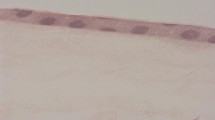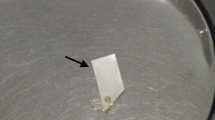Abstract
Purpose
The purpose of the study was to evaluate the outcome of the use of the temporary amniotic membrane patch (TAMP) for the treatment of primary pterygium and to investigate the mechanisms of reducing the recurrence rate.
Methods
Twenty eyes in 20 patients with primary pterygium underwent pterygium excision followed by TAMP for 5 days. Removed amniotic membrane (AM) was immunostained with primary antibodies CD34, c-Kit, STRO-1 and AC133.
Results
Within the period of follow-up (53.3±13.8 months), all the eyes showed a smooth ocular surface without recurrence of pterygium. Different grades of CD34, c-Kit, STRO-1and AC133 positive stem and progenitor cells infiltrated or attached to the stroma of patched AM, with more spindle-shaped c-Kit cells than ovoid-shaped CD34 and AC133 cells.
Conclusion
The temporary amniotic membrane patch is an effective and safe procedure for the treatment of primary pterygium. Absorbing excessive stem and progenitor cells may be one of the mechanisms of reducing the recurrence rate using AM.



Similar content being viewed by others
References
Adamis AP, Starck T, Kenyon KR (1990) The management of pterygium. Ophthalmol Clin North Am 3:611–623
Anderson DM, Lyman SD, Baird A et al (1990) Molecular cloning of mast cell growth factor, a hematopoietin that is active in both membrane bound and soluble forms. Cell 63:235–243
Azuara-Blanco A, Pillai CT, Dua HS (1999) Amniotic membrane transplantation for ocular surface reconstruction. Br J Ophthalmol 83:399–402
Boudreau N, Werb Z, Bissell MJ (1996) Suppression of apoptosis by basement membrane requires three-dimensional tissue organization and withdrawal from the cell cycle. Proc Natl Acad Sci U S A 93:3500–3513
Boyd AW (1987) Human leukocyte antigens: an update on structure, function and nomenclature. Pathology 19:329–337
Cameron ME (1983) Histology of pterygium: an electron microscopic study. Br J Ophthalmol 67:604–608
Cano-Parra J, Diaz-Llopis M, Maldonado MJ et al (1995) Prospective trial of intraoperative mitomycin C in the treatment of primary pterygium. Br J Ophthalmol 79:439–441
Dennis JE, Carbillet JP, Caplan A, Charbord P (2002) The STRO-1+ marrow cell population is multipotential. Cells Tissues Organs 170:73–82
Dushku N, Reid TW (1994) Immunohistochemical evidence that human pterygia originate from an invasion of vimentin-expressing altered limbal epithelial basal cells. Curr Eye Res 13:473–481
Dushku N, John MK, Schultz GS, Reid TW (2001) Pterygia pathogenesis: corneal invasion by matrix metalloproteinase expressing altered limbal epithelial basal cells. Arch Ophthalmol 119:695–706
Frucht-Pery J, Siganos CS, Ilsar M (1996) Intraoperative application of topical mitomycin C for pterygium surgery. Ophthalmology 103:674–677
Garlanda C, Dejana E (1997) Heterogeneity of endothelial cells: specific markers. Arterioscler Thromb Vasc Biol 17:1193–1202
Gronthos S, Graves SE, Ohta S, Simmons PJ (1994) The STRO-1+ fraction of adult human bone marrow contains the osteogenic precursors. Blood 84:4164–4173
Guler M, Sobaci G, Ilker S et al (1994) Limbal-conjunctival autograft transplantation in cases with recurrent pterygium. Acta Ophthalmol 72:721–726
Hao YX, Ma DH, Hwang DG et al (2000) Identification of anti-neovascularization proteins in human amniotic membrane. Cornea 19:348–352
Huang E, Nocka K, Beier DR et al (1990) The hematopoietic growth factor KL is encoded by the Sl locus and is the ligand of the c-kit receptor, the gene product of the W locus. Cell 63:225–233
Huss R, Moosmann S (2002) The co-expression of CD117 (c-kit) and osteocalcin in activated bone marrow stem cells in different diseases. Br J Haematol 118:305–312
Kenyon KR, Wagoner MD, Hettinger ME (1985) Conjunctival autograft transplantation for advanced and recurrent pterygium. Ophthalmology 92:1461–1470
Kim JC, Tseng SCG (1995) The effects on inhibition of corneal neovascularization after human amniotic membrane transplantation in severely damaged rabbit corneas. Korean J Ophthalmol 9:32–46
Kim JC, Tseng SCG (1995) Transplantation of preserved human amniotic membrane for surface reconstruction in severely damaged rabbit corneas. Cornea 14:472–484
Kim JS, Kim JC, Hahn TW, Park WC (2001) Amniotic membrane transplantation in infectious corneal ulcer. Cornea 20:720–726
Kobayashi N, Kabuyama Y, Sasaki S et al (2002) Suppression of corneal neovascularization by culture supernatant of human amniotic cells. Cornea 21:62–67
Lam DS, Wong AK, Fan DS et al (1998) Intraoperative mitomycin C to prevent recurrence of pterygium after excision: a 30-month follow-up study. Ophthalmology 105:901–904
Lee SB, Li DQ, Tan DT et al (2000) Suppression of TGF-beta signaling in both normal conjunctival fibroblasts and pterygial body fibroblasts by amniotic membrane. Curr Eye Res 20:325–334
Mahar PS, Nwokora GE (1993) Role of mitomycin C in pterygium surgery. Br J Ophthalmol 77:433–435
Miraglia S, Godfrey W, Yin AH et al (1997) A novel five-transmembrane hematopoietic stem cell antigen: isolation, characterization, and molecular cloning. Blood 90:5013–5021
Monselise M, Schwartz M, Politi F, Barishak YR (1984) Pterygium and beta irradiation. Acta Ophthalmol (Copenh) 62:315–319
Peault BM, Thiery JP, LeDouarin NM (1983) Surface marker for hemopoietic and endothelial cell lineages that is defined by monoclonal antibody. Proc Natl Acad Sci U S A 80:2976–2980
Prabhasawat P, Barton K, Burkett G, Tseng SCG (1997) Comparson of conjunctival autografts, amniotic membrane grafts and primary closure for pterygium excision. Ophthalmology 104:974–985
Schlingemann RO, Rietveld FJ, de Waal RM et al (1990) Leukocyte antigen CD34 is expressed by a subset of cultured endothelial cells and on endothelial abluminal microprocesses in the tumor stroma. Lab Invest 62:690–696
Schmeisser A, Strasser RH (2002) Phenotypic overlap between hematopoietic cells with suggested angioblastic potential vascular endothelial cells. J Hematother Stem Cell Res 11:69–79
Shimmura S, Shimazaki J, Ohashi Y, Tsubota K (2001) Antiinflammatory effects of amniotic membrane transplantation in ocular surface disorders. Cornea 20:408–413
Simmons PJ, Torok SB (1991) Identification of stroma cell precursors in human bone marrow by a novel monoclonal antibody, STRO-1. Blood 78:55–62
Solomon A, Pires RT, Tseng SCG (2001) Amniotic membrane transplantation after extensive removal of primary and recurrent pterygia. Ophthalmology 101:449–460
Tan DT, Chee SP, Dear KB, Lim AS (1997) Effect of pterygium morphology on pterygium recurrence in controlled trial comparing conjunctival autografting with bare sclera excision. Arch Ophthalmol 115:1235–1240
Tan DT, Lim AS, Goh HS, Smith DR (1997) Abnormal expression of the p53 tumor suppressor gene in the conjunctiva of patients with pterygium. Am J Ophthalmol 123:404–405
Tananuvat N, Martin T (2004) The results of amniotic membrane transplantation for primary pterygium compared with conjunctival autograft. Cornea 23:458–463
Tseng SCG, Prabhasawat P, Lee SH (1997) Amniotic membrane transplantation for ocular surface reconstruction in patients with chemical and thermal burns. Ophthalmology 104:2068–2076
Tseng SCG, Li DG, Ma X (1999) Suppression of transforming growth factor-beta isoforms, TGF-B receptor type II, and myofibroblast differentiation in cultured human corneal and limbal fibroblast by amniotic membrane matrix. J Cell Physiol 179:325–335
Watt SM, Karhi K, Gatter K et al (1987) Distribution and epitope analysis of the cell membrane glycoprotein (HPCA-1) associated with human hemopoietic progenitor cells. Leukemia 1:417–426
Ye J, Song YS, Kang SH et al (2004) Involvement of bone marrow-derived stem and progenitor cells in the pathogenesis of pterygium. Eye 18:839–843
Yin AH, Miraglia S, Zanjani ED et al (1997) AC133, a novel marker for human hematopoietic stem and progenitor cells. Blood 90:5002–5012
Zsebo KM, Williams DA, Geissler EN et al (1990) Stem cell factor is encoded at the Sl locus of the mouse and is the ligand for the c-kit tyrosine kinase receptor. Cell 63:213–224
Acknowledgement
We acknowledge Prof. Jae Chan Kim for his kind direction and great contribution to this research work.
Author information
Authors and Affiliations
Corresponding author
Rights and permissions
About this article
Cite this article
Ye, J., KooK, K.H. & Yao, K. Temporary amniotic membrane patch for the treatment of primary pterygium: mechanisms of reducing the recurrence rate. Graefe's Arch Clin Exp Ophthalmo 244, 583–588 (2006). https://doi.org/10.1007/s00417-005-0123-3
Received:
Revised:
Accepted:
Published:
Issue Date:
DOI: https://doi.org/10.1007/s00417-005-0123-3




